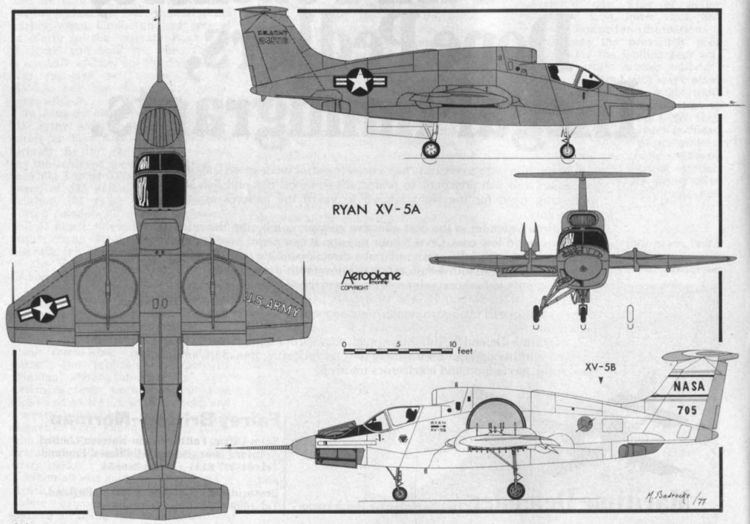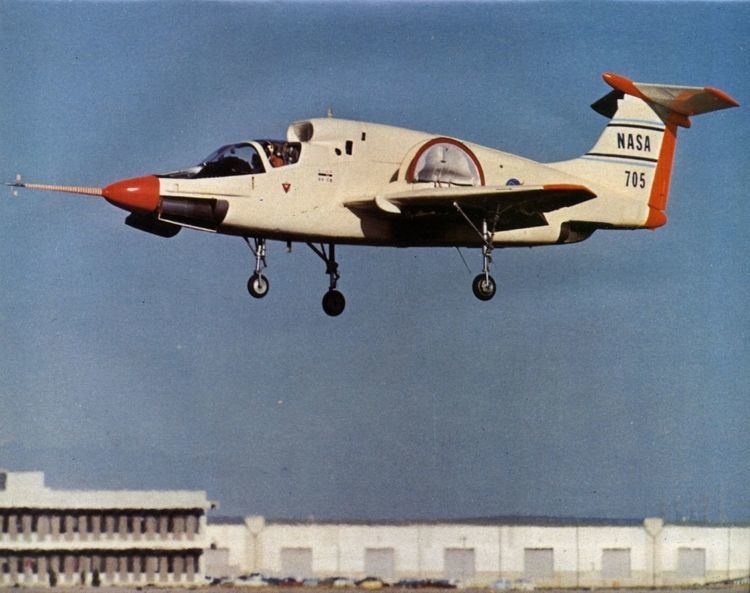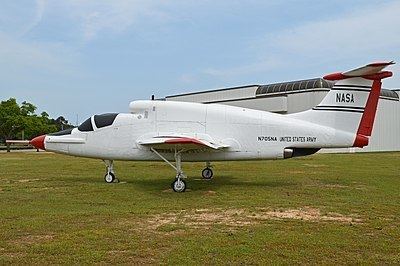Top speed 880 km/h Wingspan 9.09 m Weight 3,421 kg | Range 1,600 km Length 14 m Engine type General Electric J85 | |
 | ||
Ryan xv 5 vertifan rc model from native18
The Ryan XV-5 Vertifan was a jet-powered V/STOL experimental aircraft in the 1960s. The United States Army (US Army) commissioned the Ryan VZ-11-RY (re-designated XV-5A in 1962) in 1961, along with the Lockheed VZ-10 Hummingbird (re-designated XV-4 in 1962).
Contents
- Ryan xv 5 vertifan rc model from native18
- Ryan xv 5 vertifan
- Design
- Propulsion system
- Operational history
- Variants
- Specifications XV 5 performance estimated
- References

Ryan xv 5 vertifan
Design

The XV-5 was powered by two 2,658 lbf (11.8 kN) thrust General Electric J85-GE-5 turbojets. General Electric X353-5 Lift-fans in the wings and a smaller fan in the nose, powered by engine exhaust gas, were used for Vertical Take-Off and Landing (VTOL). The 62.5 in (1.59 m) diameter lift fan in each wing had a hinged cover on the upper wing surface which was opened for VTOL. The 36 in (0.91 m) nose fan provided adequate pitch control but produced adverse handling characteristics. The fans provided vertical lift of approximately 16,000 lbf (71.2 kN), nearly three times the thrust of the engines as turbojets.

A set of louvered vanes underneath each of the wing fans could vector the thrust fore and aft and provided yaw control. The engine power setting determined the lift from the fans, as fan RPM was determined by the exhaust output from the J85 engines and the load on the fan. Roll control was by differential actuation of the wing-fan exit louvers.

Aircraft performance was subsonic, with delta wings superficially similar to those on the A-4 Skyhawk. The Vertifan had an unusual intake position above the two-seat side-by-side seating cockpit, and a T-tail.

The XV-5A was finished in Army green and the XV-5B was painted in white NASA colors. The fans did not generate as much thrust as was hoped, and the vertical-horizontal flight transition was difficult and abrupt. The XV-5 would be one of the last manned aircraft designed and built by Ryan, which mainly manufactured drones after the mid 1960s.

The XV-5 was one of many dozens of aircraft which attempted to produce a successful vertical takeoff aircraft, but the lift fan system was heavy and occupied considerable internal volume. Only the Hawker Siddeley Harrier would still be operational by the turn of the 21st century, as would technology to make possible the use of a shaft-driven fan in the F-35.
Propulsion system
The J85 and lift-fan combination was a precursor to developments which led to the first GE high BPR engine, the TF-39. The lift fans were driven by turbine blades mounted around the periphery of the fan, with mass flow 13 times greater than the gas generators mass flow and increased thrust 3 times over that available using a propelling nozzle.
After demonstrating that large amounts of air could be moved through a lift fan, an 80 in (2.0 m) tip drive fan turned through 90 degrees, driven by a more powerful J79 engine, was built to demonstrate an efficient cruise fan. The concept of a large diameter cruise fan was incorporated in the General Electric TF39 engine, used on the Lockheed C-5 Galaxy.
Operational history
Two 12,500 lb (maximum gross weight) XV-5A were evaluated in late 1966 by fifteen test pilots (the "XV-5A Fan Club"). One was destroyed in a crash during a public flight demonstration on 27 April 1965, killing Ryan test pilot Lou Everett. Tests and promotional materials proposed a rescue version that could winch a person into a compartment behind the pilots. The second aircraft was extensively damaged in 1966 during trials as a rescue aircraft, when the test dummy was ingested into a wing fan. The pilot, Bob Tittle, was fatally injured, although it was judged that the fan actually still functioned well enough to continue controlled flight. The second aircraft was rebuilt as the modified XV-5B, with tests continuing until 1971. An XV-5B can be seen on display at the United States Army Aviation Museum, Fort Rucker, Alabama.
Variants
Specifications (XV-5) (performance estimated)
Data from Jane's All The World's Aircraft 1965–66
General characteristics
Performance
